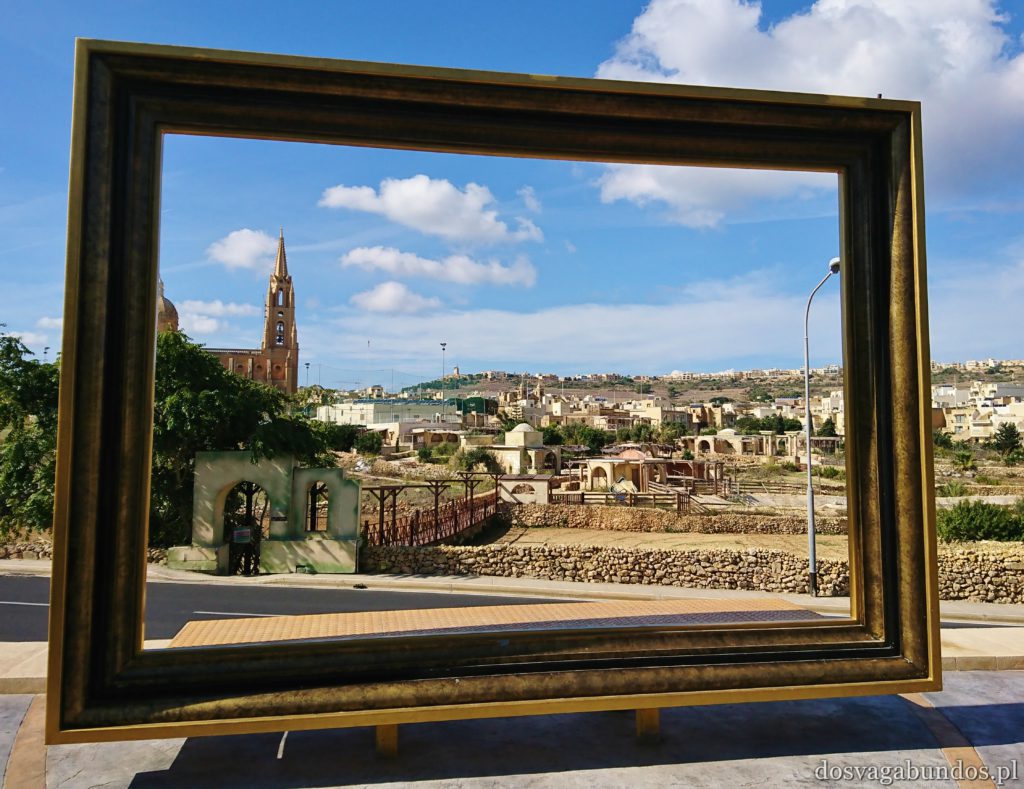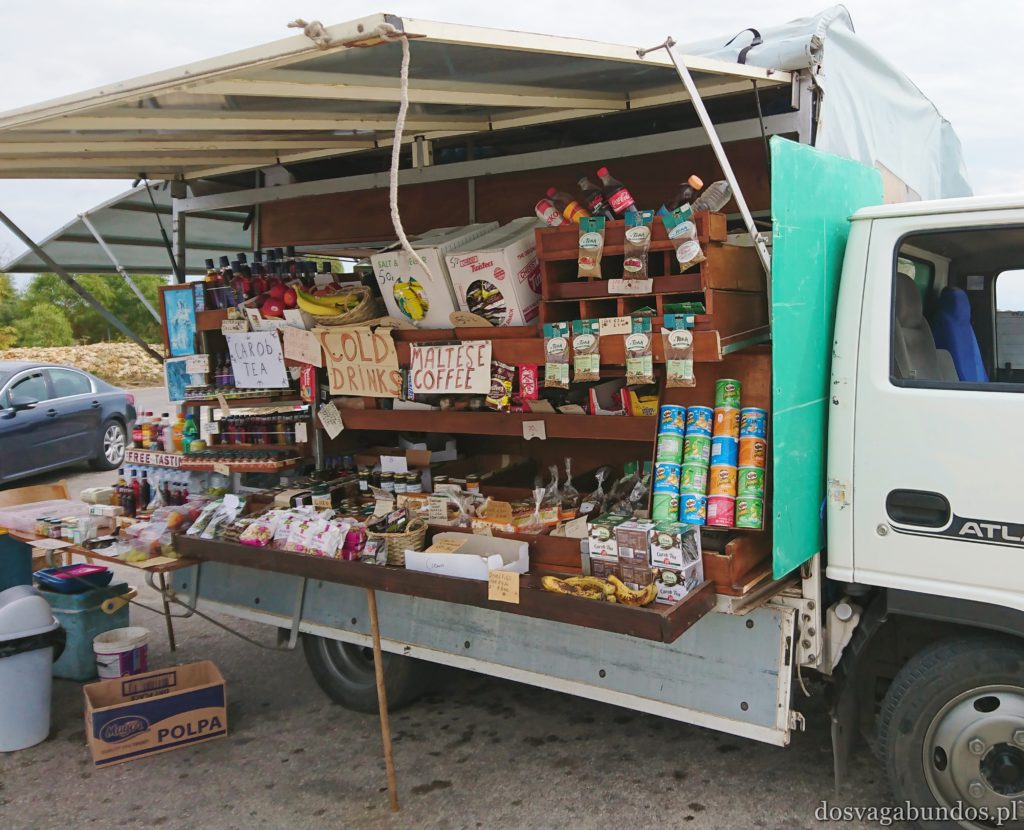Jako że na koniec ubiegłego roku już trochę zaliczyliśmy wakacji (tydzień w Izraelu, który w większości minął nam pod hasłem ulewa, ubrania na cebulkę, pizga jak w kieleckim), zostało nam na tyle mało urlopu, żeby skoczyć na drugą półkulę, a zarazem na tyle dużo, że wystarczyło na więcej niż przedłużony weekend.
Powstało więc pytanie – gdzie?
Miało być z jednej strony blisko (coby połowy odpoczynku nie spędzić w podróży), z drugiej zaś nieco egzotycznie (abyśmy odbili sobie w zakresie temperatury lutowe wczasy), niezbyt drogo, ciekawie, trochę do pozwiedzania, a trochę do poleżenia, no i last but, not least – skąd jeszcze nie wysyłaliśmy rodzinie i przyjaciołom widokówki (tak, jesteśmy ginącym gatunkiem osób inwestujących w pocztówki z wakacji).
Jednym słowem – na liście została Sardynia i Malta. Ja, jako miłośniczka pizzy i innych wspaniałości z włoskim paszportem, optowałam za pierwszą opcją. Sebastian zaś uparcie twierdził, że lepszym wyborem będzie Malta (która ponoć i ten aspekt moich oczekiwań miała zaspokajać). Niechętnie przystałam na jego propozycję, chociaż dochodziły mnie słuchy, iż jest to wyspa nudna jak flaki z olejem.
Nic bardziej mylnego. Dlatego też włażę pod stół i publicznie odszczekuje. Sebek miał rację, a ja obalę kilka haseł, którymi uraczyli mnie znajomi przed naszym wylotem.
1. Malta jest nieciekawa
Być może z perspektywy przybasenowego, hotelowego leżaka taka może się wydawać, jednak po tygodniu intensywnego zwiedzenia stwierdzam, że tyle cośmy się na niej naoglądali, to dawno nie było nam dane. Przede wszystkim pejzaże, niesamowite wytwory natury, począwszy od lazurowej i krystalicznie czystej wody, przez zjawiskowe klify, po niesamowite formacje geologiczne.
Także urokliwe miasteczka portowe, kolorowe, pełne krętych uliczek, małych sklepików z pamiątkami i knajp serwujących absolutnie przepyszne wytwory morskich głębin. To też zabytki, również prehistoryczne, monumentalne i robiące niesamowite wrażenie tak za dnia, jak i po zmroku.
Do tego śródziemnomorska kuchnia, ładna pogoda w zasadzie przez cały rok, trasy trekkingowe, rowerowe, niezliczone piesze (aczkolwiek nie wszystkie, jak się okazało, są publicznie dostępne -warto uważać na ostrzeżenia typu no entry/private…) no i oczywiście prawdziwy raj dla nurków (sporo szkół prowadzonych jest przez Polaków).
My mieszkaliśmy na Gozo, w Marsalforn i zdecydowanie polecamy tę opcję (na samą Maltę kursują non stop tanie promy – rozkład tutaj– więc połączenie ze światem odcięte w żaden sposób nie będzie).
Mimo iż jest ono tą średnią co do wielkości z Wysp Maltańskich, oferuje równie dużo co jej popularna siostra.
Owszem, nie ma już Azzure Window…
…są za to inne atrakcje, o które czasem warto też popytać miejscowych (a nie tylko ograniczać się do must see z przewodników). My dotarliśmy dzięki temu na takie smaczki, że biura podróży mogą nam całować stopy. Sebek trochę pogadał, poszperał w necie i…sami zobaczcie pierwsze z brzegu przykłady:
Dodatkowo warto poznać daty świąt, festiwali czy imprez lokalnych – można natrafić w ten sposób na nie lada biesiadę. My na ten przykład pojechaliśmy na Festiwal Ryb, zjedliśmy kolację z jakąś setką tambylców, oglądając tańce ludowe i słuchając występów maltańskich kapel. Na event ten wyjątkowo wybraliśmy się autobusem, który trochę jechał jak chciał (dlatego wróciliśmy piechotą). Resztę tras pokonywaliśmy natomiast samochodem – dzięki temu dostaliśmy się w wiele ciekawych miejsc w tak krótkich czasie. Ostrzegamy jednak – drogi są bardzo kręte, średnio oznakowane i oświetlone, a ruch lewostronny. Także ten…
Wracając jeszcze do atrakcji, zaznaczę, że nieprawdą jest iż na Malcie koniecznie trzeba odwiedzić:
2. Comino i Blue Grotto
Ośmielę się stwierdzić nawet, że to pierwsze miejsce należałoby wręcz omijać. Malutka wysepka rzeczywiście gwarantuje pocztówkowe widoki oraz ujęcia w stylu tapeta Windowsa, jednak jedynie w sytuacji, gdy wyczekasz swoje i ustawisz się pod odpowiednim kątem.
W przeciwnym wypadku całość wygląda następująco:
Pierdyliar ludzi, gazylion w wodzie, drugie tyle na skałach. Oprócz tego, żeby uważać na swoje życie (jest dość stromo), uważać tam również należy na plażowiczów, ich rzeczy, dzieci, frytki i drinki. Do tego muzyka z jachtów a’la hity manieczkowe, nad głowami zaś – oprócz błękitnego nieba- rzędy selfistików. Jak dla nas zdecydowanie NIE. Nawet przejście na drugą stronę zatoczki i pokonanie sporego kawałka dość mocno okamienionego dna niewiele nam dało – sporo osób było równie zdeterminowanych co my.
Być może o 6 rano byłoby bardziej komfortowo, ale pewno też mniej słonecznie (podczas naszego pobytu, w godzinach wczesnoporannych, zazwyczaj padało lub się mocno chmurzyło). Przyjemność popłynięcia do tego lunaparku to 10 ojro od głowy, no chyba, że decydujecie się na wersję „ze skałami” to wtedy 15. My niestety się zdecydowaliśmy i pan nas przewiózł wzdłuż nabrzeża. Well…
Aha, nadmienię jedynie, że Malta w wielu miejscach oferuje rajskie plaże i widoki for free, których znalezienie wcale nie nastręcza tylu trudności, ile by się w pierwszej chwili wydawało. I na których, werble, nie ma ludzi!
Jeśli już koniecznie chcecie, to możecie – przy okazji innych wycieczek – skoczyć do Blue Grotto. Nie spodziewajcie się jednak petardy. 15 – w porywach 20- minutowy kurs małą łódką, na której wszyscy siedzą ściśnięci jak sardynki, obejmuję dryfowanie wśród skał, które przy dobrej pogodzie rzeczywiście dość ładnie się mienią.
To jednak wszystko. A nie, przepraszam, macie przewodnika w postaci kapitana łajbki. Nasz wypowiedział 3 zdania. „Tu woda jest niebieska”. „Tu piasek jest biały”. „Czy jesteście zadowoleni z wycieczki?” (my powinniśmy byli mu w tym momencie rzucić do sakwy miliony monet w podzięce).
Ogólnie można, ale nie za wszelką cenę. Przypuszczam, że rejs tramwajem wodnym z Warszawy do Serocka dostarcza więcej wrażeń.
Podobnie rzecz się chyba ma z wioską Popeya, którą co prawda widzieliśmy tylko z zewnątrz, jednak wystarczyło nam to na wystawienie co najmniej neutralnej oceny (czyli z cyklu “nie znam się, to się wypowiem“) – ponoć drogo, a atrakcje mocno nadgryzione zębem czasu.
Generalnie lepiej te urlopowe godziny wykorzystać na poplażowanie. Tym bardziej, że wbrew kolejnej obiegowej opinii na Malcie są:
3. Plaże
Owszem, nie dominują na niej piaszczyste wypasy, jak nasza Sobieszewska czy all-inclusowe z Tunezji, niemniej i takowe się znajdą. Ciekawa jest np. gozowska Ramla w kozackim kolorze czerwonej cegły (będąc na niej możecie się wspiąć do którejś z jaskiń).
Ba, zresztą czy ten piasek jest naprawdę niezbędny do smażenia się nad wodą? Tylko z nim kłopot – wszystko utytłane, łącznie z włosami i zębami, a w połączeniu z kremem do opalania to już w ogóle nieciekawa mikstura. A tak to proszę – elegancko – ekwipunek wczasowicza czysty, wcale nie jest niewygodnie, za to widoki – jedne na milion. Rekomendujemy jednakże zakup butów do – jak ktoś kiedyś biblijne określił – chodzenia po wodzie. Skał jest dużo, fakt nie reklama, więc nie tylko przy ekspolorowaniu morskich głębin, ale nawet celem schłodzenia nagrzanego promieniami ciała, warto przyodziać się w takie tegesy. Nie są to drogie rzeczy.
Podobnie NIE jest tak, że:
4. Malta jest droga
Tzn. oczywiście tu wkraczamy na płaszczyznę mocno relatywną -w kwestii wydawania pieniędzy kategorycznie wypowiadać się nie należy, albowiem obszar ten jest wyjątkowo ocenny. Niemniej w porównaniu z innymi odwiedzanymi przez nas krajami jest przeciętnie, a biorąc na szalę takie miejsca jak Izrael, Argentyna czy polskie morze w szczycie sezonu, to ośmieliłabym się stwierdzić, że wręcz zaskakująco tanio. Za półlitrową karafkę białego, pysznego, schłodzonego wina, serwowanego w urokliwej knajpie wychodzącej wprost na morze, płaciliśmy 4 euro. Pizza w tymże miejscu – 6 orjro. (swoją drogą dla nas, miłośników kuchni kraju Don Corleone, był to istny raj – wszędzie pizzunie, makarony, mnóstwo włoskich smaków). Solidna porcja świeżej, grillowanej ryby z wiadrem frytek i sałatka – 60zł. (w tym miejscu wielkie pozdro dla Kohinoor, w którym skosztować możecie również indyjskiego jedzenia w wersji palce lizać. No i właściciele najfajniejsi na świecie. Ogólnie to ludzie na Malcie byli mili. A na pewno wychillowani).
Naszego portfela zatem specjalnie Malta nie zrujnowała, chociaż po zasłuchanych opowieściach spodziewałam się fleszy, błysków,Carringtonów, garniturów na deptakach, kolij na szyjach i szpilek na nogach. I dlatego właśnie, głupia, niesłuchająca męża ja, wzięłam japonki i sandałki, a nie zaopatrzyłam się w wygodne, letnie…
5. Obuwie
Owszem, po miejskich deptakach można dreptać w klapkach z cienkich pasków.
Co najfajniejsze na Wyspach Maltańskich to jednak kontakt z naturą, która miejsc do wspięcia się na nie, przejścia przez, pod daje multum. Niestety czasami dotarcie do nich stanowi naprawdę karkołomny wyczyn. Najlepiej przyodziać się wówczas w co najmniej adidasy, jeśli nie trapery. Zdecydowanie zaś odradzam wesolutkie zasuwanie w klapkach. Dla mnie skończyło się to poobcieranymi stopami, kolcami z ostów powbijanymi w palce i raczkowaniem po skałach, zamiast stylową wspinaczką. Aczkolwiek muszę sobie przybić piątkę za dotarcie do punktów docelowych – czasami wymagało to nie lada samozaparcia. Szczęśliwie każdorazowo czekała na mnie nagroda w postaci widoków. Milion.
Generalnie nasze wakacje okazały się mistrzem. Emocje spowodowały jednak, że postanowiłam usiąść do pisania już w samolocie (wiem, wiem, ostatnio straszliwie się w tej materii zapuściłam, warto więc było chwycić byka za rogi). Polecamy bardzo i mamy nadzieję, że będziecie równie zadowoleni co my. Można się w tej wyspie zakochać (i przy okazji w sobie na nowo).

























































































super widoki informacji bardzo dużo. Zostałam zachęcona, trzeba będzie pojechać
fajna relacja 🙂
Aluminum recycling industry Aluminium recycling procedures Scrap aluminum traders
Copper recycling network Copper scrap energy efficiency Copper scrap pricing strategy
Copper scrap volume estimation Export requirements for Copper scrap Copper scrap evaluation
Copper scrap extraction Scrap copper transportation Copper scrap disposal
Copper scrap industry publications Scrap Copper transport and logistics Copper scrap trade policies
Metal scrap processing plant Ferrous material stockpile Iron scrap salvage
Ferrous material reuse, Iron scrap collection, Scrap metal exporters
Scrap metal melting Scrap aluminium alloy processing Aluminium scrap compaction
Scrap metal recovery yard center services, Aluminum cable trader, Metal reclamation and recovery facility
Metal waste inspection services Aluminum scrap grades Scrap aluminium material testing
Scrap metal reclaiming center, Recycling aluminum electrical cables, Metal recycle yard
Metal waste treatment Aluminium scrap sorting techniques Aluminum recycling market trends
Metal waste refining, Selling aluminum cable for cash, Scrap metal transportation regulations
Metal trade compliance Aluminum industrial scrap Scrap aluminium import procedures
Scrap metal salvage yard, Aluminum cable recycling company, Bronze scrap recycling
Metal recycling solutions center services Aluminium scrap handling procedures Aluminium scrap forging
Metal reclamation facility, Aluminum cable scrap storage methods, Scrap metal ecological impact
Metal scrap recycling solutions Aluminium waste repurposing Scrap aluminium procurement
Metal scraps recovery and reprocessing, Aluminum cable scrap recycling industry, Scrap metal disposal
Scrap copper processing technology Copper scrap material analysis Copper scrap recycling companies
Scrap metal reprocessing facilities, Copper scrap cleaning, Scrap metal traders
Copper scrap commodity trading Copper sulfate is a chemical compound that is commonly used in various applications such as agriculture, industries, and laboratories. It is formed by the reaction of copper oxide or copper carbonate with sulfuric acid (H2SO4). However, copper cannot be directly reacted with an acid to produce copper sulfate. This is because copper is an unreactive metal and does not readily react with acids. In fact, when copper comes into contact with acids, it forms a thin layer of copper oxide on its surface, which acts as a protective layer preventing further reaction. As a result, copper does not dissolve in acids and cannot be used to directly produce copper sulfate. To overcome this problem, copper is first oxidized to copper oxide or copper carbonate by heating it in air or in the presence of oxygen. The resulting copper oxide or copper carbonate is then dissolved in sulfuric acid to produce copper sulfate. This process is known as the indirect process of producing copper sulfate. In summary, copper cannot be directly reacted with an acid to produce copper sulfate due to the unreactive nature of the metal. It must first be oxidized to copper oxide or copper carbonate before being dissolved in sulfuric acid to form copper sulfate Metal reclaiming and salvage Copper scrap environmental impact Copper scrap reclamation Copper scrap purchasing contracts Copper fitting recycling Metal recycle yard
Copper scrap sampling Copper is a popular choice for electrical connectors because of its unique properties. It is highly conductive, meaning that it allows electricity to flow through it easily, and it resists corrosion, which makes it perfect for use in harsh environments. Additionally, copper has a low electrical resistance, which means it produces less heat than other materials; this is important because when electrical energy is converted into heat, it can damage the connector or the device it’s connected to. Copper is also a very malleable metal, which means it can be bent and shaped without breaking or losing its strength. This makes it easy to work with and allows manufacturers to create connectors in a wide variety of shapes and sizes. It is also a ductile metal, which means it can be stretched out into a thin wire, making it ideal for use in applications where space is limited. Copper’s thermal and electrical conductivity also make it a great choice for high-speed data transmission. As data travels through copper wires and connectors, it encounters resistance, which can cause the signal to degrade. However, thanks to copper’s low electrical resistance, data can be transmitted quickly without losing quality. Overall, copper is an excellent choice for electrical connectors because of its unique combination of properties: high conductivity, corrosion resistance, low electrical resistance, malleability, and ductility. These properties make it a reliable and versatile material that is essential to the field of electrical engineering Metal scrap yard operations Copper scrap mold casting Copper recycling innovations Copper scrap recovery and reuse Secondary copper market Scrap metal repurposing innovations
Scrap metal reclamation and reclaiming Scrap metal recovery and utilization Iron recovery depot
Ferrous waste recycle yard, Iron salvage yard, Scrap metal reprocessing depot
Scrap metal quotations Ferrous material collaboration Iron scrap residue
Ferrous material recycling automation, Iron scrap recovery, Metal scrap recycling and reclamation
Metal waste reclamation and recycling Ferrous metals trading Iron waste refurbishing and reusing
Ferrous metal recycling plant, Scrap iron utilization, Scrap metal sales
Metal reusing facility Ferrous waste disassembling Iron scrap reclaiming strategies
Ferrous metals trading, Scrap iron trade, Scrap metal reclamation and reutilization